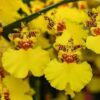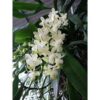# Are Oncidium Orchids Easy to Grow for Beginners?

Oncidium orchids, commonly known as “Dancing Lady Orchids,” are beloved for their stunning, intricate flowers and vibrant colors. Their unique appearance, reminiscent of a dancer in motion, has captured the hearts of many orchid enthusiasts. However, for beginners, the question often arises: are Oncidium orchids easy to grow? This article will explore the growing requirements, challenges, and tips for successfully cultivating Oncidium orchids, making them accessible for those new to the world of orchids.
## Table of Contents
1. **Introduction to Oncidium Orchids**
– 1.1 Overview of Oncidium Orchids
– 1.2 Unique Characteristics
2. **Growing Requirements for Oncidium Orchids**
– 2.1 Light Conditions
– 2.2 Temperature Preferences
– 2.3 Humidity Levels
– 2.4 Watering Needs
– 2.5 Potting Medium
– 2.6 Fertilization
3. **Common Challenges Faced by Beginners**
– 3.1 Overwatering and Root Rot
– 3.2 Underwatering
– 3.3 Pest Management
– 3.4 Environmental Fluctuations
4. **Tips for Growing Oncidium Orchids Successfully**
– 4.1 Choosing the Right Location
– 4.2 Monitoring Light and Temperature
– 4.3 Proper Watering Techniques
– 4.4 Understanding Fertilizer Needs
– 4.5 Seasonal Care
5. **Propagating Oncidium Orchids**
– 5.1 Division of Established Plants
– 5.2 Seed Propagation
6. **Conclusion**
– 6.1 Summary of Key Points
– 6.2 Final Thoughts for Beginners
## 1. Introduction to Oncidium Orchids
### 1.1 Overview of Oncidium Orchids
Oncidium orchids belong to a diverse genus that includes over 200 species and many hybrids. They are primarily native to Central and South America, thriving in tropical and subtropical environments. Oncidium orchids are particularly valued for their long-lasting blooms, which can vary widely in color, size, and shape.
### 1.2 Unique Characteristics
Oncidium orchids are characterized by:
– **Dancing Lady Appearance**: The flowers’ shape and arrangement often resemble a dancer, giving them their charming nickname.
– **Variety of Colors**: They come in numerous colors, including yellow, brown, white, and purple, often with intricate markings.
– **Growth Habit**: These orchids are epiphytes, meaning they naturally grow on other plants or surfaces, drawing moisture and nutrients from the air and rain.
## 2. Growing Requirements for Oncidium Orchids
To determine whether Oncidium orchids are suitable for beginners, it’s essential to understand their specific growing requirements.
### 2.1 Light Conditions
Oncidium orchids thrive in bright, indirect light.
– **Ideal Lighting**: A spot with filtered sunlight, such as near an east or west-facing window, is perfect for these orchids. Too much direct sunlight can scorch their leaves, while too little light can hinder flowering.
– **Light Adjustment**: If your orchid is not blooming, it may require more light; conversely, yellowing leaves could indicate excessive light exposure.
### 2.2 Temperature Preferences
Temperature is another critical factor in growing Oncidium orchids successfully.
– **Daytime Temperatures**: They prefer daytime temperatures between 70°F to 85°F (21°C to 29°C).
– **Nighttime Temperatures**: Night temperatures should ideally range from 55°F to 65°F (13°C to 18°C). This temperature drop is crucial for triggering flowering.
### 2.3 Humidity Levels
Oncidium orchids thrive in humid environments.
– **Ideal Humidity**: A humidity level of 40% to 70% is optimal. Low humidity can lead to leaf drop and poor growth.
– **Humidity Solutions**: To maintain humidity, consider using a humidifier, pebble trays, or misting your plants regularly.
### 2.4 Watering Needs
Proper watering is vital for the health of Oncidium orchids.
– **Watering Frequency**: Watering should be done when the potting medium feels dry to the touch. Oncidium orchids typically need watering once a week, but this can vary based on the season and environment.
– **Watering Technique**: Always water thoroughly, allowing excess water to drain out of the pot. This helps prevent root rot, which can occur if the roots remain too wet.
### 2.5 Potting Medium
The right potting medium is essential for the health of Oncidium orchids.
– **Recommended Medium**: A well-draining orchid mix, often containing bark, perlite, and sphagnum moss, is ideal for Oncidium orchids.
– **Repotting**: Repotting is necessary every 1-2 years to refresh the medium and provide room for growth.
### 2.6 Fertilization
Fertilizing your Oncidium orchids is crucial for their growth and flowering.
– **Fertilizer Type**: Use a balanced orchid fertilizer, typically a 30-10-10 formula, diluted to half strength.
– **Feeding Schedule**: Fertilize every two weeks during the growing season (spring and summer) and reduce frequency in the fall and winter.
## 3. Common Challenges Faced by Beginners
While Oncidium orchids are beautiful and rewarding to grow, beginners may encounter some challenges.
### 3.1 Overwatering and Root Rot
Overwatering is one of the most common issues faced by orchid beginners.
– **Symptoms of Root Rot**: Yellowing leaves, wilting, and mushy roots are signs of root rot. To prevent this, ensure proper drainage and only water when the medium is dry.
– **Recovery**: If root rot occurs, remove the orchid from its pot, trim away the rotten roots, and repot in fresh, dry medium.
### 3.2 Underwatering
Conversely, underwatering can also be problematic.
– **Signs of Underwatering**: Shriveling leaves and dry, brittle roots indicate that your orchid needs more water. It’s crucial to establish a regular watering schedule.
– **Hydration Techniques**: Consider soaking the pot in water for a few minutes to ensure thorough hydration if the medium is excessively dry.
### 3.3 Pest Management
Pests can pose a threat to Oncidium orchids.
– **Common Pests**: Aphids, mealybugs, and spider mites are frequent pests that can affect orchids.
– **Control Methods**: Regularly inspect your plants for pests and treat infestations promptly with insecticidal soap or neem oil.
### 3.4 Environmental Fluctuations
Sudden changes in the environment can stress Oncidium orchids.
– **Temperature Changes**: Rapid fluctuations in temperature can lead to leaf drop and poor growth. Try to maintain stable conditions.
– **Drafts and Direct Air**: Avoid placing orchids near drafty windows or direct air conditioning, which can cause stress and affect growth.
## 4. Tips for Growing Oncidium Orchids Successfully
With the right knowledge and practices, beginners can successfully grow Oncidium orchids.
### 4.1 Choosing the Right Location
Selecting an appropriate location for your Oncidium orchids is crucial.
– **Bright, Indirect Light**: Place your orchids where they can receive bright but filtered light, such as near a sheer curtain or in a well-lit room.
– **Avoiding Direct Sunlight**: Ensure they are not exposed to harsh direct sunlight, especially during the hottest parts of the day.
### 4.2 Monitoring Light and Temperature
Regularly monitor the light and temperature conditions for your orchids.
– **Use Thermometers and Light Meters**: These tools can help you maintain the right environment for your plants.
– **Adjust as Necessary**: Be prepared to adjust the positioning of your orchids based on seasonal changes in light and temperature.
### 4.3 Proper Watering Techniques
Implementing proper watering techniques is essential for healthy growth.
– **Check Soil Moisture**: Use your finger to check the moisture level of the potting medium before watering.
– **Water Thoroughly**: Ensure you water evenly and thoroughly, allowing excess water to drain freely.
### 4.4 Understanding Fertilizer Needs
Understanding how and when to fertilize your orchids can enhance their growth.
– **Regular Feeding Schedule**: Stick to a consistent fertilization schedule during the growing season for the best results.
– **Observing Plant Responses**: Monitor your plants’ growth and adjust your fertilization routine based on their responses.
### 4.5 Seasonal Care
Different seasons require different care strategies.
– **Spring and Summer**: Focus on regular watering and fertilization during the active growth phase.
– **Fall and Winter**: Reduce watering and fertilization as the plant enters dormancy, allowing it to conserve energy.
## 5. Propagating Oncidium Orchids
For those interested in expanding their collection, propagation can be a rewarding endeavor.
### 5.1 Division of Established Plants
One of the most common methods of propagating Oncidium orchids is through division.
– **Timing**: The best time to divide is after the plant has finished blooming, typically in late spring or early summer.
– **Process**: Carefully remove the orchid from its pot, gently separate the pseudobulbs, and repot each section in fresh medium.
### 5.2 Seed Propagation
Seed propagation is less common and requires more specialized techniques.
– **Challenges**: Growing orchids from seeds is complex and often takes years
to produce flowering plants.
– **Considerations**: This method is generally best left to advanced growers due to the technical requirements.
## 6. Conclusion
### 6.1 Summary of Key Points
Oncidium orchids can indeed be grown successfully by beginners with the right knowledge and care. Understanding their light, temperature, humidity, and watering needs is essential for healthy growth. Although challenges such as pests and environmental fluctuations may arise, implementing proper techniques and monitoring can lead to thriving plants.
### 6.2 Final Thoughts for Beginners
In conclusion, Oncidium orchids are an excellent choice for beginners who are willing to invest time and care into their cultivation. With vibrant blooms and unique characteristics, these orchids can be a stunning addition to any home. By following the tips outlined in this article, you can enjoy the beauty of Oncidium orchids and experience the joy of nurturing these remarkable plants. Whether you’re growing them for personal enjoyment or to share with friends and family, Oncidium orchids are sure to bring beauty and elegance to your space.

